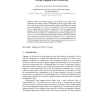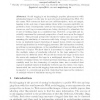WISE
2009
Springer
14 years 8 months ago
2009
Springer
Web2.0 has brought tagging at the forefront of user practises for organizing and locating resources. Unfortunately, these tagging efforts suffer from a main drawback: lack of inter...
WISE
2009
Springer
14 years 8 months ago
2009
Springer
Peer-to-peer (P2P) systems have been recently proposed for providing search and information retrieval facilities over distributed data sources, including web data. Terms and their ...
WISE
2009
Springer
14 years 8 months ago
2009
Springer
Abstract. This paper proposes to exploit content and usage information to rearrange an inverted index for a full-text IR system. The idea is to merge the entries of two frequently ...
WISE
2009
Springer
14 years 8 months ago
2009
Springer
Social tagging is an increasingly popular phenomenon with substantial impact on the way we perceive and understand the Web. For the many Web resources that are not self-descriptive...
WISE
2009
Springer
14 years 8 months ago
2009
Springer
In this paper, we describe an approach for detection and visualization of coordinate term relationships over time and their evolution using temporal data available on the Web. Coor...
WISE
2009
Springer
14 years 8 months ago
2009
Springer
The visual creation tools in the mashup frameworks are supposed to be simple and accessible. Yet at the same time there is a need to extend the capabilities and complexity of mashu...
WISE
2009
Springer
14 years 8 months ago
2009
Springer
Identifying the right-grained services is important to lead the successful service orientation because it has a direct impact on two major goals: the composability of loosely-coupl...
WISE
2009
Springer
14 years 8 months ago
2009
Springer
ct One significant effort towards combining the virtues of Web search, viz. being accessible to untrained users and able to cope with vastly heterogeneous data, with those of dat...
WISE
2009
Springer
14 years 8 months ago
2009
Springer
In this paper, we present a Web recommender system for recommending, predicting and personalizing music playlists based on a user model. We have developed a hybrid similarity match...
WISE
2009
Springer
14 years 8 months ago
2009
Springer
Web-based environments typically span interactions between humans and software services. The management and automatic calculation of trust are among the key challenges of the futur...


